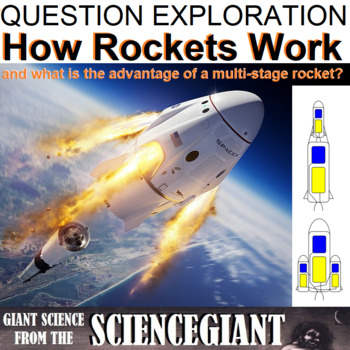Question Exploration and Lab: How Do Rockets Work?
- Word Document File
Description
How Do Rockets Work? This Question Exploration helps Ss explain how Does a Rocket Work, and What is the Main Advantage of a Multi-stage Rocket?
Question Exploration Routine is an instructional methods that teachers can use to help a diverse student population understand a body of content information by carefully answering a critical question to arrive at a main idea answer. Students taught using the Content Enhancement routines earned higher total test scores than did students taught using the lecture-discussion method.
Personally, I use the Question Exploration Routine to figure out what I want to say and how I want to say it. It keeps my "Sage on the Stage" time limited to what fits onto 2-3 pages (about 45 minutes of directed class discussion). This product includes the completed question exploration guide, and the student guide blanked except for vocabulary, scaffolding questions, and graphics already filled in.
The lab activity provides learners with a template to create a rocket that can be launched from a soda straw during a hands-on activity. Ss are challenged to modify the design to see how the changes impact the rocket performance. Length (or angle or force) can be changed–one variable at a time–to see how the rocket improves compared to the control design.
This Strategic Instruction has been classroom tested to help Ss with the following Florida Next Generation Sunshine State Standards in Science.
Students Will Be Able To (SWBAT)
- SC.8.E.5.10 Assess how technology is essential to science for such purposes as access to outer space and other remote locations, sample collection, measurement, data collection and storage, computation, and communication of information.
- SC.8.E.5.12 Summarize the effects of space exploration on the economy and culture of Florida.
- SC.8.N.4.2 Explain how political, social, and economic concerns can affect science, and vice versa.
- SC.912.N.4.1 Explain how scientific knowledge and reasoning provide an empirically-based perspective to inform society's decision making.
- SC.912.N.4.2 Weigh the merits of alternative strategies for solving a specific societal problem by comparing a number of different costs and benefits, such as human, economic, and environmental.
- SC.912.E.5.7 Relate the history of and explain the justification for future space exploration and continuing technology development.
- SC.912.E.5.9 Analyze the broad effects of space exploration on the economy and culture of Florida.
Related Resource
- October Sky video viewing and after activities
- Apollo 13 video viewing and after activities
- Hidden Figures video viewing and after activities
- Question Exploration: What Was the Space Race? (Rocket Rivals Russia and USA)
#StayGiant and stay up on my new resources and STEM news. Look for the green ★ star near the top of any page within my store and click "FOLLOW". Or follow @TheScienceGiant Twitter. Stand on The Shoulders of Giants, and together we'll see further, inspire students, and enlighten inquisitive minds!





